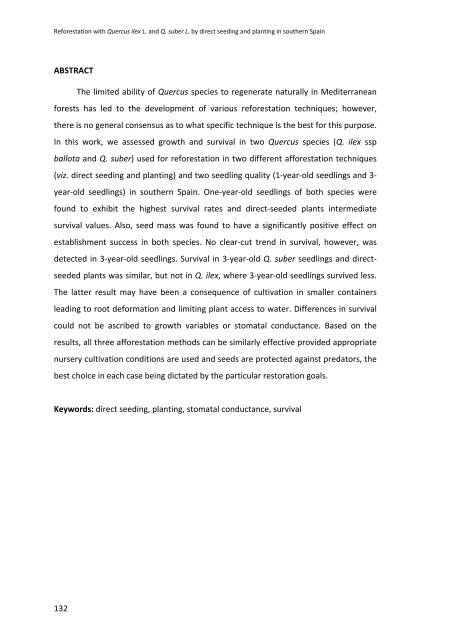Establecimiento de cuatro especies de Quercus en el sur de la ...
Establecimiento de cuatro especies de Quercus en el sur de la ...
Establecimiento de cuatro especies de Quercus en el sur de la ...
Create successful ePaper yourself
Turn your PDF publications into a flip-book with our unique Google optimized e-Paper software.
Reforestation with <strong>Quercus</strong> ilex L. and Q. suber L. by direct seeding and p<strong>la</strong>nting in southern Spain<br />
ABSTRACT<br />
The limited ability of <strong>Quercus</strong> species to reg<strong>en</strong>erate naturally in Mediterranean<br />
forests has led to the <strong>de</strong>v<strong>el</strong>opm<strong>en</strong>t of various reforestation techniques; however,<br />
there is no g<strong>en</strong>eral cons<strong>en</strong>sus as to what specific technique is the best for this purpose.<br />
In this work, we assessed growth and <strong>sur</strong>vival in two <strong>Quercus</strong> species (Q. ilex ssp<br />
ballota and Q. suber) used for reforestation in two differ<strong>en</strong>t afforestation techniques<br />
(viz. direct seeding and p<strong>la</strong>nting) and two seedling quality (1‐year‐old seedlings and 3‐<br />
year‐old seedlings) in southern Spain. One‐year‐old seedlings of both species were<br />
found to exhibit the highest <strong>sur</strong>vival rates and direct‐see<strong>de</strong>d p<strong>la</strong>nts intermediate<br />
<strong>sur</strong>vival values. Also, seed mass was found to have a significantly positive effect on<br />
establishm<strong>en</strong>t success in both species. No clear‐cut tr<strong>en</strong>d in <strong>sur</strong>vival, however, was<br />
<strong>de</strong>tected in 3‐year‐old seedlings. Survival in 3‐year‐old Q. suber seedlings and directsee<strong>de</strong>d<br />
p<strong>la</strong>nts was simi<strong>la</strong>r, but not in Q. ilex, where 3‐year‐old seedlings <strong>sur</strong>vived less.<br />
The <strong>la</strong>tter result may have be<strong>en</strong> a consequ<strong>en</strong>ce of cultivation in smaller containers<br />
leading to root <strong>de</strong>formation and limiting p<strong>la</strong>nt access to water. Differ<strong>en</strong>ces in <strong>sur</strong>vival<br />
could not be ascribed to growth variables or stomatal conductance. Based on the<br />
results, all three afforestation methods can be simi<strong>la</strong>rly effective provi<strong>de</strong>d appropriate<br />
nursery cultivation conditions are used and seeds are protected against predators, the<br />
best choice in each case being dictated by the particu<strong>la</strong>r restoration goals.<br />
Keywords: direct seeding, p<strong>la</strong>nting, stomatal conductance, <strong>sur</strong>vival<br />
132

















